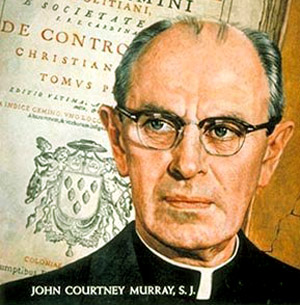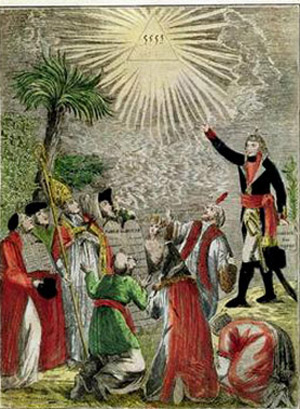In light of the talks between the Vatican and the Society of St. Pius X,
there have recently been many articles in the traditional Catholic
media about religious liberty and Dignitatis Humanae (DH).
Critics generally wrestle with the attempt to reconcile DH with
traditional Catholicism. While the Church has always maintained that the
public manifestation of false religions could be tolerated in
exceptional circumstances, DH asserts that people must be granted a
positive "civil right" to publicly practice and propagate any and all
religions, within due limits. Hence: religious liberty à la Vatican II.

American Jesuit Courtney Murray, one of the inspirers of Dignitatis Humanae
|
Here are the key phrases in DH taken from the Vatican’s own website: "No
one is to be forced to act in a manner contrary to his own beliefs,
whether privately or publicly, whether alone or in association with
others, within due limits." (1) And, "This right of the human person to
religious freedom is to be recognized in the constitutional law whereby
society is governed and thus it is to become a civil right." (2)
The consequences of the doctrine of DH on religious liberty are so grave
that there appears to be reluctance by critics to confront the overall
picture – they don’t want to see the forest, or refuse to acknowledge
it, but focus instead on the trees.
The document’s stand on religious freedom shamefully repudiates the
First Commandment of the Old Testament by legalizing the worship of
false gods. It also essentially neutralizes the teaching of the New
Testament that salvation is through Jesus Christ alone. In addition, DH
constitutes a renunciation of any spiritual or moral rights and duties
that the Church, by Divine Right, has over the State, since Jesus Christ
is King of kings and Lord of lords. These are not merely
discontinuities with tradition, or legitimate developments of doctrine –
they are apostasies.
Even the Catholic confessional state is rendered toothless by DH, which
states: If, in view of peculiar circumstances obtaining among peoples,
special civil recognition is given to one religious community in the
constitutional order of society, it is at the same time imperative that
the right of all citizens and religious communities to religious freedom
should be recognized and made effective in practice (3)
This is why, in the wake of the Council, the Concordats between the
Vatican and the few nations that still professed Catholicism as their
official religion had to be modified to allow equal public rights to
other religions and gods. Thus the Council has attempted to roll a
permanent stone over the sepulcher of Christendom.
One writer on this issue has stated that the qualification that the
public practice of false religions must be "within due limits" is the
saving grace of DH. He expresses hope that in the Vatican / SSPX talks
the pope will clarify these variable, changeable limits. (4)
But how can any due limits be applied to the public worship of false
gods, in terms of a positive right? The true Church could never admit to
such a guaranteed civil right to disobey the first and greatest
commandment, in order to allow the worship of demons and idols, within
"due limits." Again it is a reluctance to see the forest and admit the
gravity of what DH proposes.
A drop of poison
Pope Leo XIII in his encyclical Satis Cognitum (5) warned of the
necessity to guard the integrity of the faith against those who would
differ in any point from the true doctrine of the Church. Even if they
admit the whole cycle of doctrine, "by one word, as with a drop of
poison" they are able to infect the Apostolic Faith.

Like Napoleon, above, Vatican II's allows anyone to worship a 'Supreme Being'
|
DH is a perfect example of what Pope Leo warned about. It pays the
required obeisance to the Divine Order, and to the one true religion
which is the Catholic Church ... excuse me, which "subsists" in the
Catholic Church. It is replete with truisms and platitudes that no one
should be coerced into adopting a particular religion.
But we find the poison subtly administered in the very first section of
DH: Religious freedom, in turn, which men demand as necessary to fulfill
their duty to worship God, has to do with immunity from coercion in
civil society. Therefore it leaves untouched traditional Catholic
doctrine on the moral duty of men and societies toward the true religion
and toward the one Church of Christ.
Over and above all this, the council intends to develop the doctrine of
recent popes on the inviolable rights of the human person and the
constitutional order of society. (6)
Notice that the traditional doctrine is admitted, that men and societies
have a moral duty to the true religion and Church. Then we read in the
very next line "Over and above all this …"
In other words, above this doctrine, and over this doctrine, and in
addition to this doctrine, the Council will "develop" another doctrine –
that of the "rights" of man and societies. DH then proceeds to
supersede and override the doctrine of the moral duty of states and
individuals to the true Catholic Religion and its traditional doctrines,
with its newly developed doctrine on religious liberty.
One little drop of poison, just a few words: "Over and above all this…"
"Over and above" in the Vatican’s English version is translated from
"insuper" in the official Latin DH, which according to the University of
Notre Dame’s online Latin dictionary means: "above, overhead; over and
above, in addition, besides." (7)
1. Declaration on Religious Freedom, Dignitatis Humanae, December 7, 1965,www.vatican.va, Section 2, paragraph 1.
2. Ibid., Section 2, paragraph 2.
3. Ibid., Section 6, paragraph 4.
4. John Salza, J.D., http://www.remnantnewspaper.com/Archives/2009-1115-salza-vaticansspx_discussion.htm
5. Leo XIII, Pope, Encyclical Satis Cognitum, June 29, 1896, www.vatican.va.
6. Dignitatis Humanae, Section 1, paragraphs 4, 5.
7. Latin Dictionary and Grammar Aid, University of Notre Dame, http://archives.nd.edu/latgramm.htm.
|


